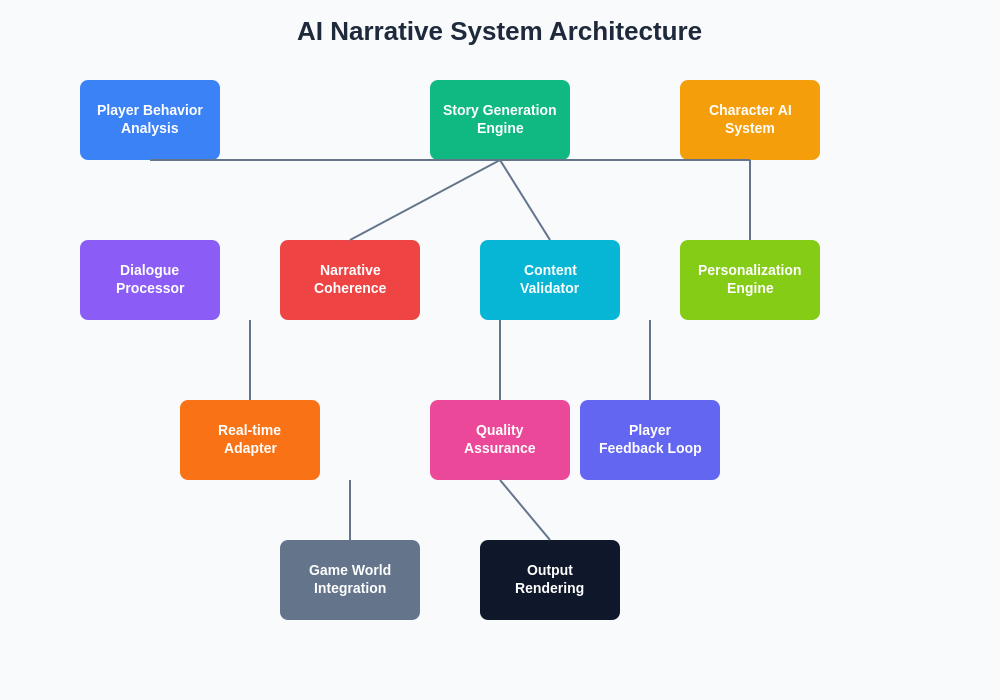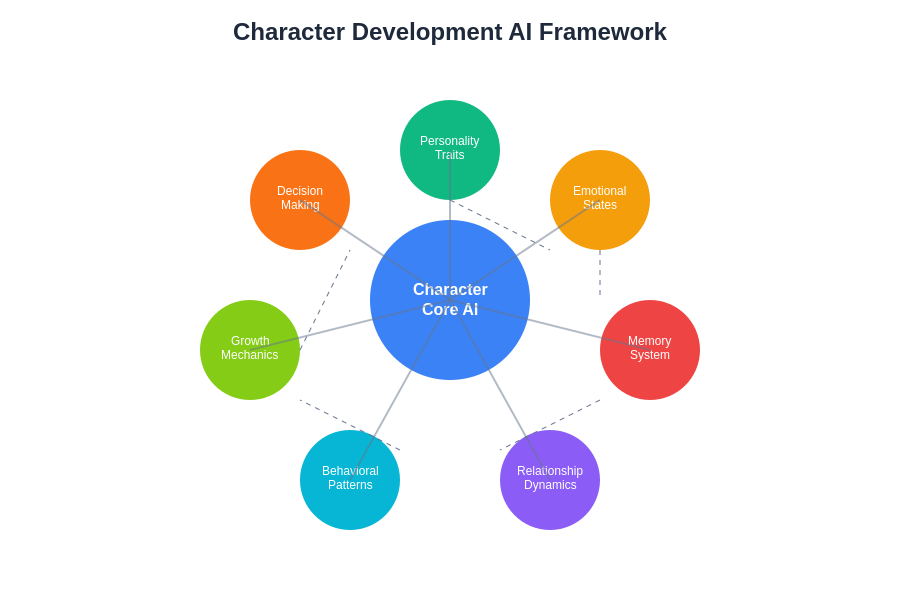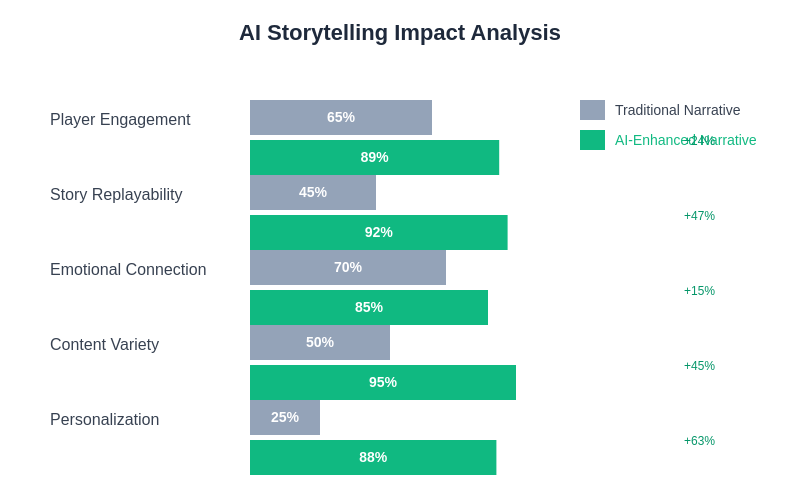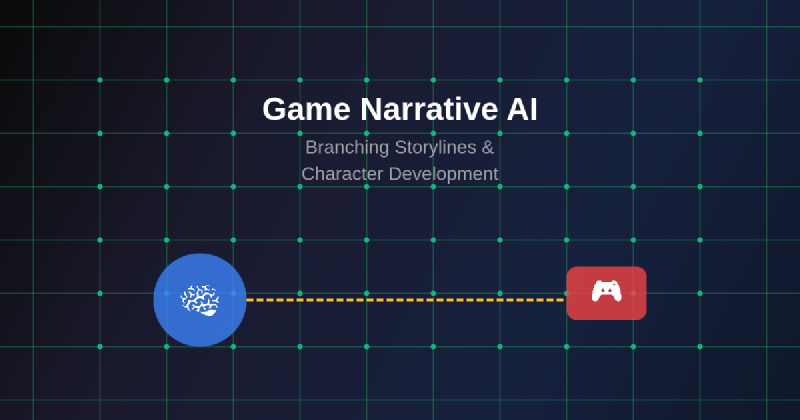The evolution of video game storytelling has reached an unprecedented pinnacle with the integration of artificial intelligence into narrative design, fundamentally transforming how players experience interactive entertainment. Game narrative AI represents a revolutionary approach to storytelling that transcends traditional linear narratives, creating dynamic, responsive, and deeply personalized gaming experiences that adapt to individual player choices, preferences, and playing styles in real-time.
Explore the latest gaming AI innovations to discover cutting-edge technologies that are reshaping the interactive entertainment landscape. The convergence of sophisticated AI algorithms with creative storytelling has opened new frontiers in game design, enabling developers to craft narratives that are not merely predetermined paths but living, breathing stories that evolve based on player interaction and decision-making patterns.
The Foundation of AI-Driven Narrative Systems
Traditional video game narratives have long been constrained by predetermined storylines, fixed character arcs, and limited branching paths that, while offering some player agency, ultimately funnel players toward predetermined conclusions. Game narrative AI shatters these limitations by introducing sophisticated systems capable of generating, modifying, and personalizing story content in real-time based on complex player behavior analysis, emotional response detection, and preference learning algorithms that create truly unique narrative experiences for each individual player.
The foundation of these AI-driven narrative systems rests upon advanced natural language processing capabilities, machine learning algorithms trained on vast databases of literary works and successful game narratives, and sophisticated player behavior modeling systems that can predict and respond to player preferences with remarkable accuracy. These technologies work in concert to create narrative experiences that feel both authored and spontaneous, maintaining the quality and coherence expected from professionally crafted stories while introducing elements of unpredictability and personalization that were previously impossible to achieve.

The architectural complexity of modern AI narrative systems demonstrates the sophisticated integration of multiple artificial intelligence components working together to create seamless, engaging storytelling experiences. Each component contributes essential functionality to the overall narrative generation process while maintaining real-time responsiveness to player actions and preferences.
Dynamic Branching Storylines Through Machine Learning
The implementation of machine learning algorithms in game narrative design has enabled the creation of branching storylines that extend far beyond simple binary choices or predetermined decision trees. Modern AI narrative systems can generate thousands of potential story branches, each influenced by subtle player behaviors, dialogue choices, exploration patterns, and even physiological responses detected through advanced gaming peripherals that monitor heart rate, stress levels, and engagement metrics.
These sophisticated branching systems utilize reinforcement learning algorithms that continuously adapt narrative content based on player engagement levels, ensuring that story developments maintain optimal pacing and emotional impact. The AI analyzes player reactions to different narrative elements, learning which types of plot developments, character interactions, and story themes resonate most strongly with individual players, then dynamically adjusts future narrative content to maximize emotional engagement and story satisfaction.
Experience advanced AI storytelling with Claude to understand how sophisticated language models can enhance creative writing and narrative development across various media platforms. The integration of large language models into game development workflows has revolutionized how writers and designers approach interactive storytelling, providing tools that can generate coherent, engaging narrative content while maintaining consistency with established story worlds and character personalities.
Intelligent Character Development and Personality Systems
Character development in AI-powered games transcends traditional static personality systems, introducing dynamic character growth that responds to player interactions, story events, and environmental factors in ways that mirror real human psychological development. These advanced character AI systems utilize personality modeling frameworks based on psychological research, incorporating established personality theories such as the Big Five personality traits, attachment theory, and cognitive behavioral patterns to create characters that exhibit realistic personality development over time.
The sophistication of these character development systems allows for the creation of non-player characters who remember past interactions, develop emotional relationships with the player character, and undergo meaningful personality changes based on shared experiences and story events. Characters may develop trust or suspicion, form romantic attachments, experience trauma that affects their behavior patterns, or undergo philosophical transformations based on the moral choices and actions demonstrated by the player throughout the gaming experience.
Procedural Narrative Generation and Content Creation
Procedural narrative generation represents one of the most ambitious applications of AI in game storytelling, enabling the creation of entirely new story content that maintains narrative coherence while providing unlimited replayability. These systems utilize advanced natural language generation models trained on extensive narrative datasets, combined with sophisticated world-building algorithms that can create consistent fictional universes, character backstories, and plot developments that feel organically connected to the established game world.
The implementation of procedural narrative systems requires careful balancing between creative freedom and narrative quality control, utilizing multiple AI models working in concert to ensure that generated content meets quality standards while maintaining consistency with established lore, character personalities, and world-building elements. These systems incorporate feedback loops that analyze player responses to generated content, continuously refining their output to better match player preferences and maintain high engagement levels.

The architectural complexity of modern AI narrative systems demonstrates the sophisticated integration of multiple artificial intelligence components working together to create seamless, engaging storytelling experiences. Each component contributes essential functionality to the overall narrative generation process while maintaining real-time responsiveness to player actions and preferences.
Emotional Intelligence and Player Psychology
The integration of emotional intelligence into game narrative AI represents a significant advancement in creating deeply engaging and psychologically satisfying gaming experiences. These systems utilize sentiment analysis, emotional state recognition, and psychological profiling to understand not just what players choose to do, but why they make those choices and how those decisions affect their emotional state and overall engagement with the narrative experience.
Advanced emotional intelligence systems can detect patterns in player behavior that indicate stress, frustration, boredom, or excitement, then dynamically adjust narrative pacing, difficulty levels, and story content to maintain optimal emotional engagement. This might involve introducing tension-relieving moments during high-stress sequences, escalating dramatic tension when players appear disengaged, or providing emotional catharsis through character interactions and story revelations that address the player’s current psychological state.
Adaptive Dialogue Systems and Conversational AI
The evolution of dialogue systems in AI-driven games has moved far beyond simple dialogue trees and predetermined response options, incorporating sophisticated conversational AI that can generate contextually appropriate, personality-consistent dialogue in real-time. These systems utilize advanced natural language processing to understand player intent, emotional tone, and communication style, then generate responses that feel natural and authentic while advancing the narrative and character development goals of the game.
Modern adaptive dialogue systems can maintain conversation continuity across multiple gaming sessions, remember previous conversations and their emotional context, and adapt their communication style to match the player’s preferences and established relationship dynamics. Characters can develop unique speaking patterns, inside jokes, and conversational callbacks that create a sense of genuine relationship development and shared history between the player and non-player characters.
Discover comprehensive AI research capabilities with Perplexity to explore the latest developments in conversational AI and natural language processing technologies that are transforming interactive entertainment and digital communication across multiple industries.
Personalization Through Player Behavior Analysis
Player behavior analysis forms the cornerstone of personalized narrative experiences, utilizing sophisticated data collection and analysis systems to understand individual player preferences, playing styles, and emotional responses to different narrative elements. These systems track countless data points including choice patterns, exploration behavior, combat preferences, social interaction tendencies, and even subtle timing patterns in decision-making to build comprehensive player profiles that inform narrative customization.
The depth of personalization achievable through modern player behavior analysis extends beyond simple preference matching to include psychological profiling that can predict player responses to different narrative scenarios. This enables AI systems to craft story experiences that challenge players in meaningful ways, introduce narrative elements that align with their interests and values, and create emotional moments that resonate with their personal experiences and psychological makeup.
Real-Time Story Adaptation and Dynamic Pacing
Real-time story adaptation represents one of the most technically challenging aspects of AI-driven narrative systems, requiring sophisticated algorithms capable of modifying ongoing storylines without breaking narrative coherence or creating plot inconsistencies. These systems must constantly evaluate the current story state, player engagement levels, and available narrative resources to make intelligent decisions about story pacing, dramatic tension, and plot development that maintain optimal player engagement.
Dynamic pacing systems utilize machine learning algorithms trained on successful narrative structures from literature, film, and games to understand optimal story rhythm and dramatic timing. These systems can detect when players are experiencing narrative fatigue, excitement peaks, or emotional saturation, then adjust story pacing accordingly by introducing action sequences, character development moments, exploration opportunities, or dramatic revelations at precisely the right moments to maintain peak engagement.
Collaborative Storytelling and Player Agency
The concept of collaborative storytelling in AI-driven games extends traditional notions of player agency by creating narrative experiences where players become active co-creators of the story rather than passive recipients of predetermined content. These systems recognize player creative input through various channels including character customization choices, environmental interactions, dialogue contributions, and even direct narrative input through sophisticated text processing systems that can incorporate player-generated content into the ongoing story.
Advanced collaborative storytelling systems can analyze player creative contributions for thematic consistency, narrative relevance, and quality standards, then seamlessly integrate approved elements into the ongoing narrative experience. This creates a sense of genuine ownership and investment in the story outcome while maintaining the coherence and quality standards expected from professional narrative content.

The sophisticated framework governing AI-driven character development demonstrates the complex interplay between personality modeling, behavioral analysis, and narrative progression that creates believable, evolving characters capable of forming meaningful relationships with players over extended gaming experiences.
Technical Implementation and Development Challenges
The technical implementation of AI-driven narrative systems presents numerous complex challenges that require innovative solutions and careful architectural planning. These systems must process vast amounts of data in real-time, maintain narrative consistency across potentially infinite story branches, and provide seamless integration with existing game mechanics and systems without compromising performance or player experience quality.
Development teams working on AI narrative systems must address challenges including computational resource management, content generation quality control, narrative coherence maintenance across branching storylines, and the integration of AI-generated content with traditionally authored game elements. These technical challenges require expertise in multiple domains including machine learning, natural language processing, game development, narrative design, and user experience optimization.
Quality Assurance and Content Moderation
Quality assurance for AI-generated narrative content presents unique challenges that extend beyond traditional game testing methodologies to include content appropriateness evaluation, narrative coherence verification, and cultural sensitivity assessment. AI narrative systems must incorporate sophisticated content moderation algorithms that can identify potentially problematic content including inappropriate language, culturally insensitive themes, or narrative elements that might negatively impact player mental health or well-being.
Advanced quality assurance systems utilize multiple layers of content evaluation including automated screening algorithms, human reviewer validation, and community feedback integration to ensure that AI-generated content meets quality standards while maintaining creative freedom and narrative innovation. These systems must balance creative expression with responsible content creation, particularly in games that reach diverse global audiences with varying cultural backgrounds and sensitivity levels.
Future Innovations and Emerging Technologies
The future of game narrative AI promises even more sophisticated storytelling capabilities through emerging technologies including advanced neural networks, quantum computing applications, virtual reality integration, and brain-computer interfaces that could enable direct emotional and psychological state monitoring. These technological advances will enable the creation of narrative experiences that respond not just to player actions but to their subconscious reactions, emotional states, and even physiological responses to story events.
Emerging technologies such as generative AI models specifically trained for creative writing, advanced emotion recognition systems, and sophisticated virtual reality implementations will enable the creation of narrative experiences that blur the boundaries between traditional entertainment media and immersive virtual experiences. These advances will fundamentally transform how players interact with digital stories and characters, creating opportunities for emotional connections and narrative engagement that rival and potentially surpass traditional media formats.

The measurable impact of AI-driven storytelling systems on player engagement, retention, and satisfaction demonstrates the significant advantages of personalized narrative experiences compared to traditional linear storytelling approaches in interactive entertainment.
Industry Impact and Market Transformation
The implementation of AI-driven narrative systems is transforming the gaming industry by enabling smaller development teams to create narrative experiences that rival those produced by large studios, democratizing high-quality storytelling capabilities and fostering innovation in interactive entertainment. These technologies are reducing development costs while increasing content variety and replayability, creating new business models based on personalized content delivery and ongoing narrative experiences that evolve over time.
The market transformation enabled by narrative AI extends beyond gaming into adjacent industries including interactive fiction, educational software, training simulations, and therapeutic applications where personalized storytelling can enhance learning outcomes, emotional engagement, and behavioral modification goals. This expansion of AI narrative applications demonstrates the broad potential for these technologies to influence how humans interact with digital content across multiple domains.

The measurable impact of AI-driven storytelling systems on player engagement, retention, and satisfaction demonstrates the significant advantages of personalized narrative experiences compared to traditional linear storytelling approaches in interactive entertainment.
Ethical Considerations and Responsible Development
The development of AI-driven narrative systems raises important ethical considerations regarding player manipulation, psychological impact, and data privacy that require careful attention from developers, researchers, and regulatory bodies. These systems’ ability to analyze player psychology and emotional responses creates opportunities for both positive engagement enhancement and potentially harmful manipulation that must be addressed through responsible development practices and ethical guidelines.
Responsible development of narrative AI systems requires consideration of player autonomy, informed consent regarding data collection and analysis, transparency about AI involvement in content generation, and safeguards against psychological manipulation or harmful content exposure. The gaming industry must develop comprehensive ethical frameworks that balance innovation and creative freedom with player protection and responsible technology deployment.
Conclusion and Future Prospects
Game narrative AI represents a fundamental transformation in interactive entertainment that promises to revolutionize how players experience digital stories while creating unprecedented opportunities for personalized, emotionally engaging gaming experiences. The continued evolution of these technologies will likely produce narrative experiences that challenge our understanding of the boundaries between human creativity and artificial intelligence, creating new forms of collaborative storytelling that enhance rather than replace human creative expression.
The future development of game narrative AI will require continued collaboration between technologists, creative professionals, psychologists, and ethicists to ensure that these powerful tools are deployed in ways that enhance human creativity, promote positive emotional experiences, and respect player autonomy while pushing the boundaries of what is possible in interactive entertainment. The successful implementation of these technologies promises to usher in a new era of gaming where every player’s story is unique, personally meaningful, and emotionally resonant.
Disclaimer
This article is for informational purposes only and does not constitute professional advice regarding game development, artificial intelligence implementation, or investment decisions in gaming technologies. The views expressed are based on current understanding of AI technologies and their applications in interactive entertainment. Readers should conduct their own research and consult with qualified professionals when considering the implementation of AI-driven narrative systems. The effectiveness and appropriateness of AI narrative technologies may vary depending on specific use cases, target audiences, and implementation approaches.
